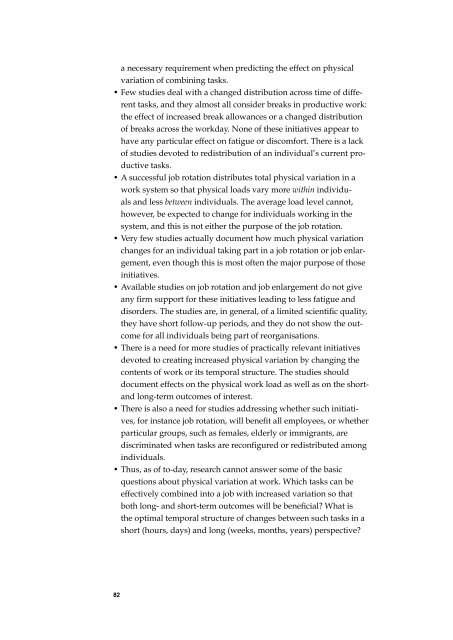Fysisk variation och belastningsbesvär i arbetet
7FwiihSQY
7FwiihSQY
Create successful ePaper yourself
Turn your PDF publications into a flip-book with our unique Google optimized e-Paper software.
a necessary requirement when predicting the effect on physical<br />
<strong>variation</strong> of combining tasks.<br />
• Few studies deal with a changed distribution across time of different<br />
tasks, and they almost all consider breaks in productive work:<br />
the effect of increased break allowances or a changed distribution<br />
of breaks across the workday. None of these initiatives appear to<br />
have any particular effect on fatigue or discomfort. There is a lack<br />
of studies devoted to redistribution of an individual’s current productive<br />
tasks.<br />
• A successful job rotation distributes total physical <strong>variation</strong> in a<br />
work system so that physical loads vary more within individuals<br />
and less between individuals. The average load level cannot,<br />
however, be expected to change for individuals working in the<br />
system, and this is not either the purpose of the job rotation.<br />
• Very few studies actually document how much physical <strong>variation</strong><br />
changes for an individual taking part in a job rotation or job enlargement,<br />
even though this is most often the major purpose of those<br />
initiatives.<br />
• Available studies on job rotation and job enlargement do not give<br />
any firm support for these initiatives leading to less fatigue and<br />
disorders. The studies are, in general, of a limited scientific quality,<br />
they have short follow-up periods, and they do not show the outcome<br />
for all individuals being part of reorganisations.<br />
• There is a need for more studies of practically relevant initiatives<br />
devoted to creating increased physical <strong>variation</strong> by changing the<br />
contents of work or its temporal structure. The studies should<br />
document effects on the physical work load as well as on the shortand<br />
long-term outcomes of interest.<br />
• There is also a need for studies addressing whether such initiatives,<br />
for instance job rotation, will benefit all employees, or whether<br />
particular groups, such as females, elderly or immigrants, are<br />
discriminated when tasks are reconfigured or redistributed among<br />
individuals.<br />
• Thus, as of to-day, research cannot answer some of the basic<br />
questions about physical <strong>variation</strong> at work. Which tasks can be<br />
effectively combined into a job with increased <strong>variation</strong> so that<br />
both long- and short-term outcomes will be beneficial? What is<br />
the optimal temporal structure of changes between such tasks in a<br />
short (hours, days) and long (weeks, months, years) perspective?<br />
82



